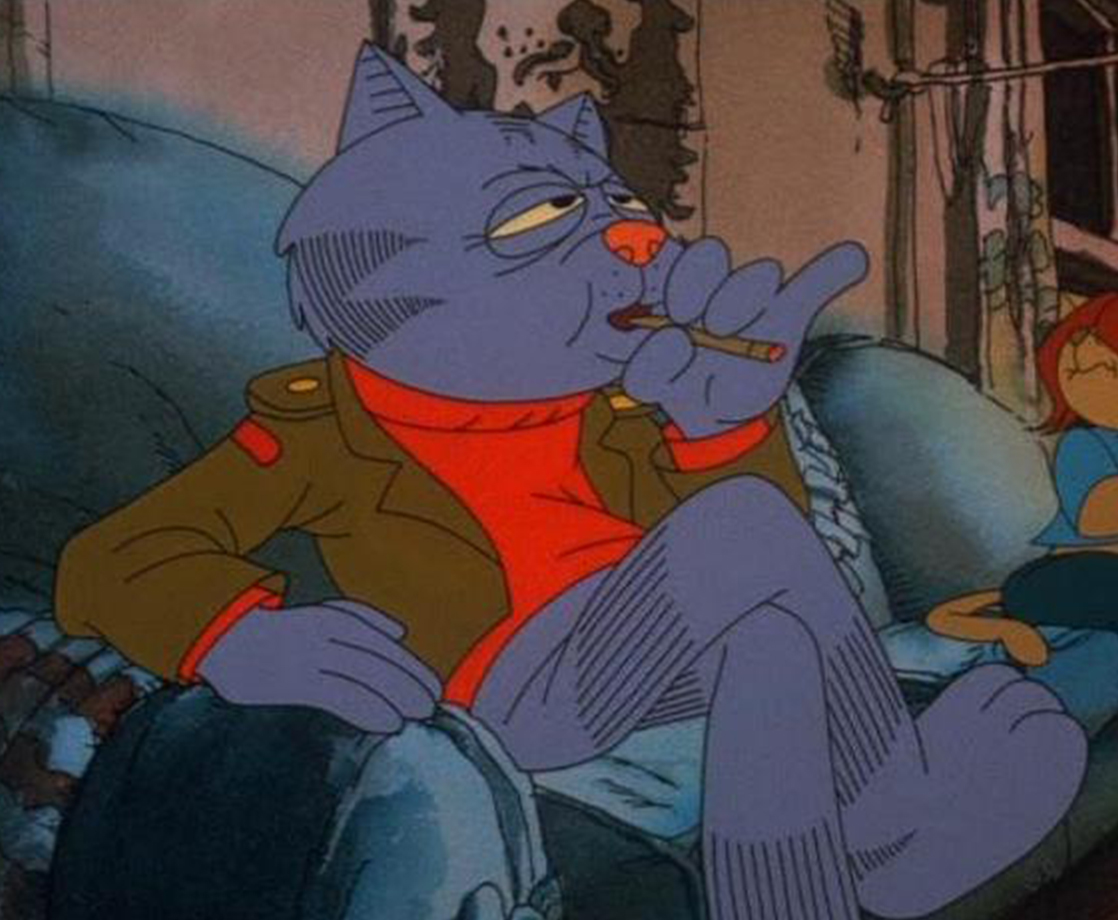Fritz The Cat celebrates its 35th anniversary this year, a notable birthday for an unsuspectingly landmark film. With a rare X-rating from the MPAA, and a film that pushed the line of decency and good taste, Fritz The Cat became a surprising juggernaut, raking in $90 million on a $850,000 budget. Thanks largely to a decade of Hollywood deregulation that allowed independent cinema a place in the market and a cut of the pie, Fritz remains the highest grossing independent animated film of all time. It's no Miyazaki, but it's a marvel in its own bizarre right.
The 1972 film is a marriage of one of underground comix's most beloved and infamous illustrators, R. Crumb, and director Ralph Bakshi, a pioneer of adult-oriented animated films. Bakshi's influence can be felt everywhere, from Batman: The Animated Series (which celebrated its 25 anniversary earlier this month) to the entire Pixar cannon, which, while significantly more family-friendly, still infused a children's medium with the nuances and intention of adult storytelling.
R. Crumb, on the other hand, remains a slightly more obtuse though no less revered figure, somewhat closer to an Alan Moore than a Stan Lee (though much like Lee, Bakshi would call Crumb "one of the slickest hustlers you'll ever see in your life"). Crumb remains a talisman of the counterculture era; his work has appeared in enclaves as varied as the East Village Observer and comic shops to, more recently, the gallery walls of David Zwirner in Chelsea. Crumb's illustration work ranges from sardonic to accusatory, wanton (sometimes even straight-up perverted) to wholesome — both of its time and overwhelmingly nostalgic for a simpler era before it.
The film is similarly both a celebration of and screed against an era of political alertness that Bakshi seems to believe houses more than a shred of moral agnosticism. In the comics, which ran from 1965 to 1972, Fritz gets himself into strange misadventures as a means of coxing women. His presence in the comic strip that made him famous is largely a play on the misadventures of all anthropomorphic cartoon animals that predated him. Inspired by the cartoons of the 1920-30s, the Fritz found in underground comix like Cavalier and Help! is a mix of Wiley E. Coyote and Mickey Mouse at once.
In Fritz The Cat, the movie, he's a con artist who declares his allegiance to the burgeoning scene of coffee house hipsters and on-the-road poets as a means of reaching enlightenment. The film opens with a title card that reads simply "the 1960s," and Fritz seems to be have doubled down on the era's interest in experiencing life for life's sake, and all the women that come with it. Sex is the driving force for all Fritz's actions, with drugs either a way to take solace in various failures or as a way to re-energize his waning libido.

The presence of weed serves a very specific narrative purpose when, towards the end of the film, Fritz gets stoned and becomes convinced that he is the defacto leader of a movement meant to enlighten others and change the world at large. But this fetishizing of protest is precisely the film's target. The film opens amidst a street protest, with R. Crumb's signature love of folk-era America sifting through the air, as protesters chant in unison. Meanwhile, Fritz and his friends watch as women coo over a crow, the film's proxy for black Americans. The girls are well read; they mentioning loving Baldwin's grasp of the African American experience. The attention is enviable, if problematic by 2017's standards — though the film's satirizing of this kind of patronization helps solidify its thesis of faux-resistance as alarmingly relevant. Fritz, nevertheless, is taken by the scene, and what follows is a bildungsroman about a fake radical, whose every move — sparking protest, wooing women, attempting to get in with the authentic "crow" community in Harlem — rarely results in anything but chaos.
Fritz is about a young American (in this case, cat) awakening to the culture around him, and finding it to be both the answer to his most hedonistic desires and a direct reflection of them. Bored by college, the film essentially follows him as he hitches his wagon onto anybody who can make good on a promise of change, like Holden Caulfield mixed with one of the very phonies the character loathed. Fritz is tired of the boring day-to-day drudge of existence, and revolution seems like, if not the answer to all the world's problems, certainly a good time. The sex he craves, the drugs he's tempted by, the writing he wants to do — he reveres poets, though perhaps for their female-alluring prowess more than their prose — have all been wrapped up in the eye of an approaching storm.
That storm is the decade that Crumb worked in, one we still look back on with a certain amount of rose-eyed curiosity. Fritz The Cat is a satire fit to withstand nostalgia because it is itself already suspicious of the era's desires. Illuminating them through a cartoon cat is just a way to make the medicine go down easier.

In contemporary context, the film delves a bit too freely into strange stereotypes, with animals as proxies for different races like some deranged Zootopia. But what makes Fritz The Cat fascinating to look back on today is the way in which it inverts the DNA of Fritz as a means to investigate the social mores of the 1960s. The film is, in effect, less an allegory and more of a documentation of the era.
While the satire is deafening, the film subverts the traditional norms of animated filmmaking by approaching the voiceover as documentary. Aside from Skip Hinnant, who voices Fritz as both Machiavellian con man and boyish imp, many of the other characters had their dialogue lifted from real conversations Bakshi himself recorded. To capture the film's opening scene, Bakshi paid construction workers $50 a piece, and supplied them with a bottle Scotch, recording them as they lambasted the entitlement of an entire generation.
The strange effect this creates — the tempo of real conversation set to the frenetic motion of a cartoon — manages to capture the mood of drugs better than most films with real people. Psychedelic in design and hazy in pace, the film's narrative begins to buzz more and more with the feverish speed of a cartoon, but the animation seems to move like molasses. It's an absurd technique that only becomes more engrossing with time.

In a way, Fritz The Cat is a precursor to an entire generation of bawdy animated film. In the decades to follow, The Simpsons would invert the traditional dynamics of the family sitcom; South Park would rattle the quiet conservatist panic of the late 1990s, erupted in the wake of school shootings, the emergence of violent video games, and angrier music. But they were viewed as catalysts, not documents. Those shows would serve as bridge, linking the growing despondence between tradition and culture.
But Fritz The Cat, in its quiet genius, was born out of a short period in which there were no rules left to break. Film had become the wild west — the violence of Bonnie and Clyde, the sexual-frankness of Midnight Cowboy, the grotesque absurdity of John Waters — and Fritz The Cat is an example of a film so of-its-moment that it manages to still feel shocking, even today. During the 1970s, sensation had all but replaced sentiment, making sex and violence a new kind of central nervous system for art. As the years progressed, violence would be expounded upon in entertainment, whereas sex would morph into something ever-present, but quieter. Fritz The Cat teems with so much of both that its mere presence on screen feels like an eruption, an orgasm celebrating the pleasure of being able to show pleasure at all (and the film does — Fitz engages in no less than three fairly graphic sex scenes, all of which are without exaggeration some of the film's highest points).
Looking at the film on its 35th anniversary, its mere existence is a testament to the experimentation and freedom of the era. Yet the film itself seems critical of those same vehicles of change, questioning their salability, their sincerity, and their motivation. It frames 1960s counterculture as a prevailing presence in discourse and art, yet it's never too sure of what to make of them. Revolution is farce, born out of a bad trip; free love is hedonism rebranded. The film opens in New York, and we end in Hollywood, a tell-tale sign that either California is the promise land or every sense of revolution is in some way theatre. Fritz The Cat is a satire meant to reveal that cartoons and revolutionaries are often in sync, except one knows better than to color outside the lines.
Follow Rod Bastanmher on Twitter











